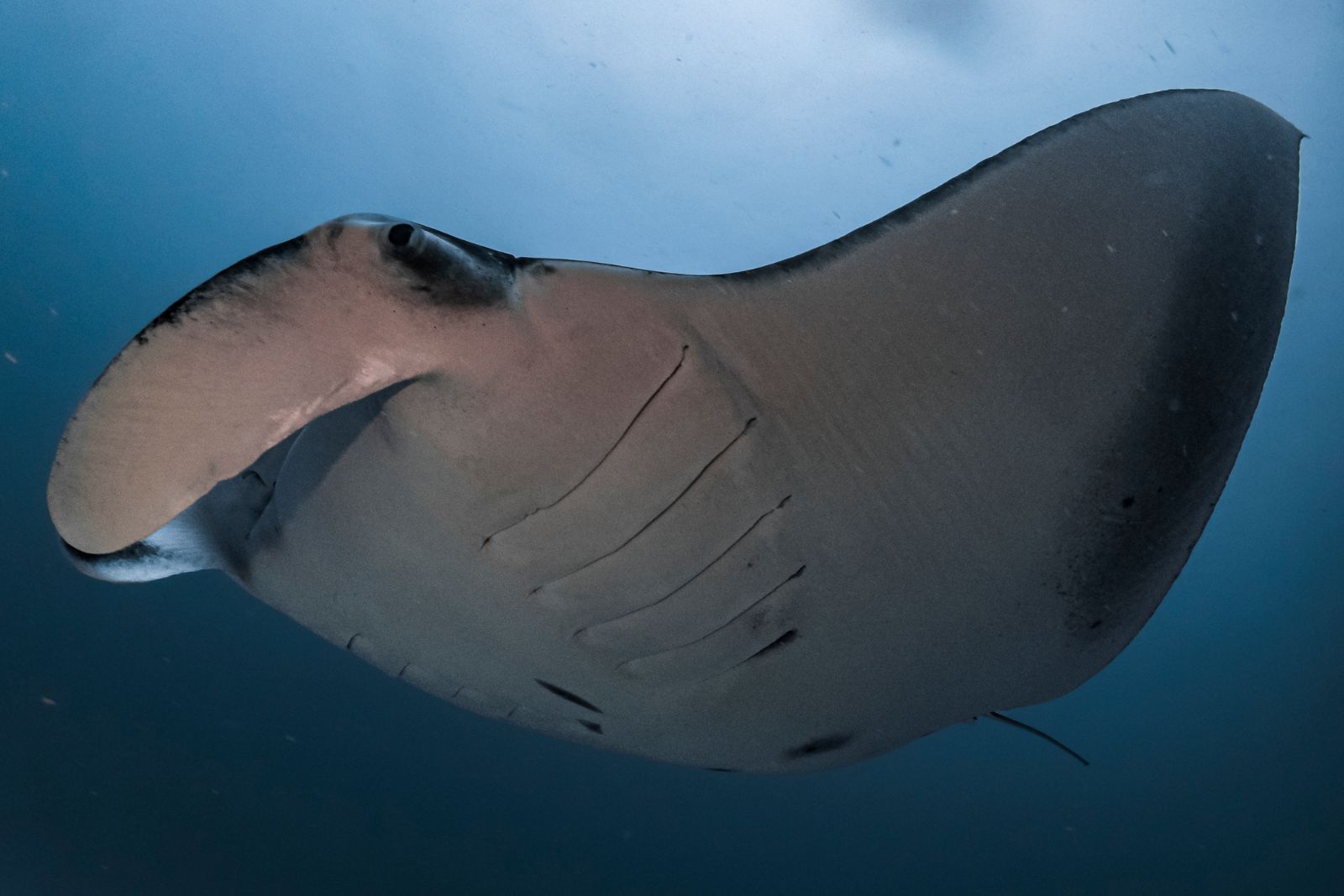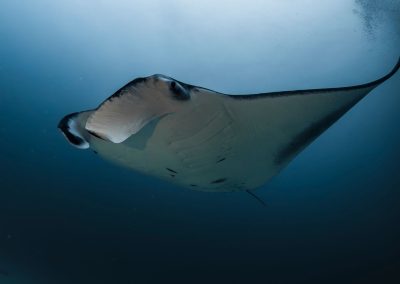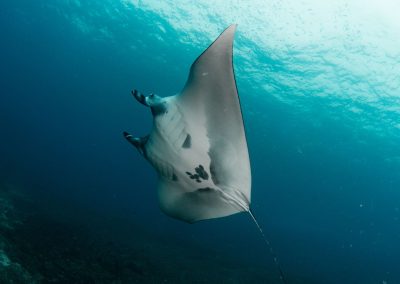Manta rays might seem smooth and elegant from a distance, but their skin does a lot more than make them look good. It protects them, helps them move through the water, and plays a role in how they experience their environment. But it’s also surprisingly fragile, which is one of many reasons we always say: please don’t touch the mantas.
The mucus coating: a slimy shield that keeps mantas healthy
Like other fish, manta rays are covered in a thin mucus layer. It’s their built-in defense system. This coating acts as a barrier against bacteria, helps them heal from minor injuries, and reduces friction as they swim.
This layer also helps with energy efficiency, especially during long-distance travel. It’s a minor feature with a big job: helping mantas stay healthy in a vast and sometimes dangerous ocean.
But the coating is easily damaged. Scrapes from coral, stings from sea creatures, or even close contact with another manta (e.g., during mating) can wear it down. Once the layer is compromised, mantas are vulnerable to infection or irritation, and it’s not always clear how long it takes for the coating to regenerate fully.
It’s the main reason why we’re very strict about hands-off encounters. Watching a manta glide by is magical enough. There’s no need to reach out.
Dermal denticles: tiny teeth on the manta ray’s skin
Beneath the slime, manta rays have something called dermal denticles. These are tiny, tooth-like scales (the name literally means “skin teeth”). They give parts of the manta’s body a texture similar to fine sandpaper.
These denticles do a few important things:
- Help reduce drag so mantas can swim more efficiently
- Add a layer of protection against scrapes or bumps
- Help the manta sense touch and pressure changes in the water
Denticles are found on sharks and other rays, too, but manta ray denticles are usually smoother and more evenly spaced. In fact, the shape and pattern of these structures vary by species. Oceanic mantas (Mobula birostris) have overlapping denticles with tiny cusps, while reef mantas (Mobula alfredi) have smoother, more spaced-out ones.
In some species, the denticles are more concentrated on the back and upper body, where protection and streamlining are most useful. Scientists sometimes use these details to identify species or even individuals.
What manta ray skin feels like
Over the years, our team has been hit or “slapped around” by mantas a few times. Their skin feels both slimy and rough: slippery in some areas, like a wet fish, and grainy in others, like fine sandpaper. That combination comes from the protective mucus layer on top of the denticles.
While it’s fascinating to know what they feel like, the best way to appreciate their skin is to observe, not touch. Any physical contact, even accidental, can interfere with the manta’s natural defenses.
When manta skin gets damaged
Even though mantas are graceful swimmers, their skin isn’t invincible. One of the most common signs of damage is redness or abrasions, especially on their cephalic fins or ventral side.
Some of this happens naturally. Mantas occasionally scrape against coral or rocks or get roughed up during mating behavior. But in other cases, humans cause the damage. Even a small touch can break down the protective coating and expose the skin.
Propellers, fishing lines, and hooks can cause more serious injuries. These can slice into fish’s soft tissue or get wrapped around their fins, sometimes leaving deep scars or lasting deformities.
Wounds can take weeks or even months to heal, depending on the severity and whether the slime coating can regenerate properly. Repeated damage may lead to chronic irritation or long-term scarring.
In this article, we documented how Melaniah Ray, one of the manta rays of Kona, recovered from a fishing line injury that left a deep cut on her right wing. Otto Dee Ray also suffered skin abrasions on his underbelly, likely due to human impact. You can see photos of his recovery on this page.
Reefs can hurt manta rays, too
It’s not always people who do the damage: We’ve seen mantas with sea urchin spines stuck in their fins or mouths, likely from getting too close to the reef. Lava rocks, coral outcrops, and fishing debris can also leave their mark.
For the most part, mantas are elegant in their movements. Still, they can be surprisingly clumsy when feeding or circling close to the reef, especially in rough water or low visibility. Their size doesn’t help either; it only takes a small misjudgment to result in an injury.
How we keep track of manta ray injuries
We’ve been keeping track of the manta rays along the Kona Coast for over 20 years in our Manta Ray Library. Each manta has a unique pattern on its underbelly, which is how we tell them apart. They all have names and distinct personalities.
In the library, you’ll find profiles of many Kona mantas who’ve been injured or scarred. We monitor their wounds and healing progress through underwater photos and detailed observations.
We share this data with academics and institutions conducting ongoing research into manta health and behavior, as well as conservation groups.
Look, don’t touch
Manta rays rely on their mucus coating and dermal denticles to stay safe and healthy. Once that system is disrupted, the consequences can last a long time.
So, if you’re lucky enough to swim with a manta ray, enjoy the experience. Give them space, stay calm, and only interact passively. And keep your hands to yourself.
It’s a privilege to be near these animals. Let’s treat it that way.














0 Comments